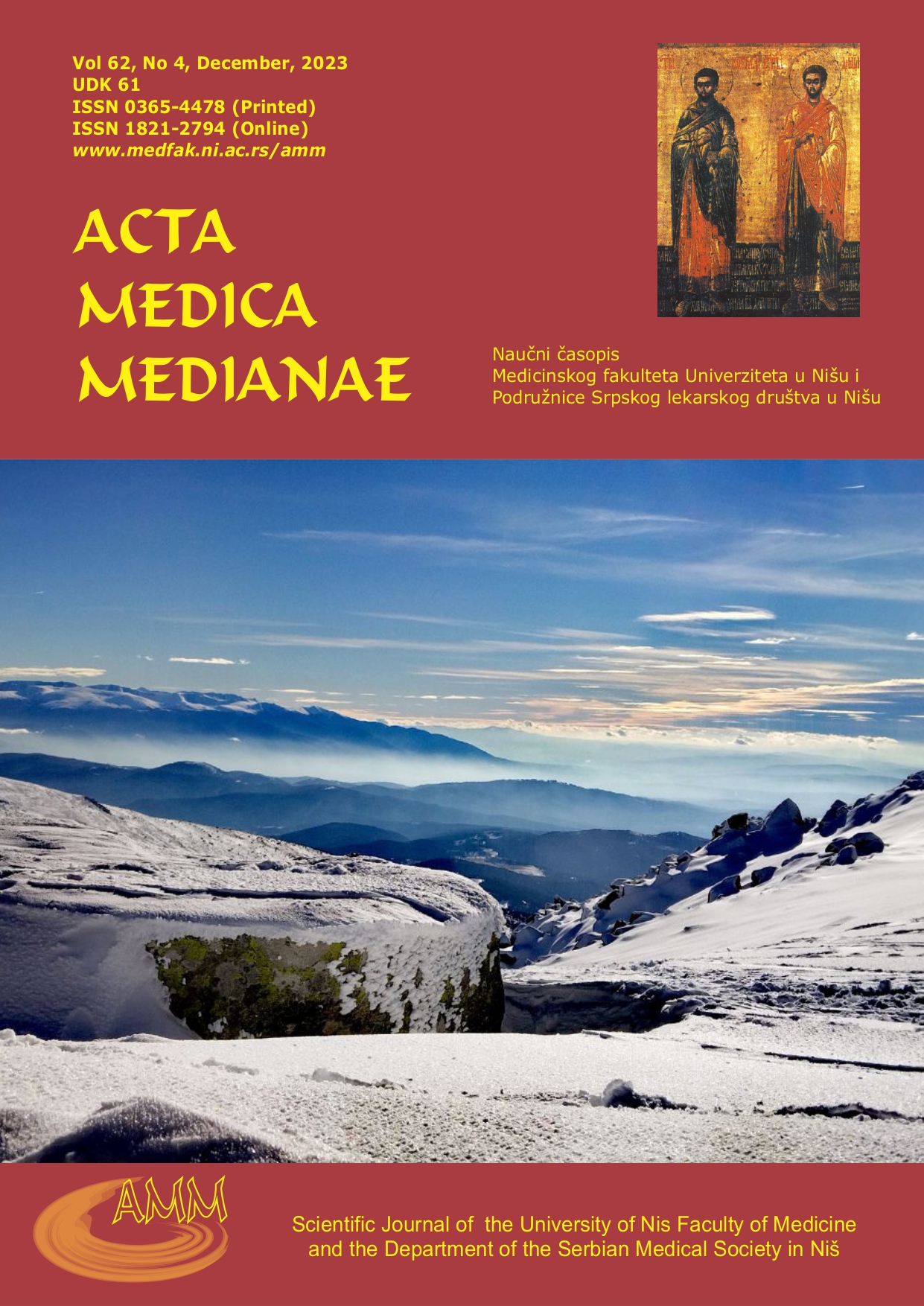RISK FACTORS AND CLUSTER ANALYSIS OF ONYCHOMYCOSIS
Abstract
Risk factors and cluster analysis of onychomycosis
Abstract
Introduction: Recently, there has been a trend of identifying different disease phenotypes based on clinical parameters. Cluster analysis is a statistical method for categorizing different clinical signs and symptoms based on how closely associated they are.
The Aim: Estimate whether cluster analysis can be used to classify distinct clinical phenotypes of onychomycosis and determine risk factors for this infection.
Material and Methods: This prospective study evaluated data from the specially designed questionnaire for superficial fungal infections of the skin and adnexa. The questionnaire was composed of three separate groups of questions, including demographic data, symptoms and clinical signs and risk factors. The hierarchical method of cluster analysis, the Ward method with Euclidian distance, was used in statistical analysis.
Results: The applied statistical method separated patients into two clusters based on clinical presentation. The first cluster consisted of patients with onychomycosis of toenails accompanied by pain, complete destruction of the nail plate, involvement of 2/3 of the nail, and nail thickening greater than 2 mm. The second cluster, patients with onychomycosis of fingernails, was further divided into two subclusters. The first one included patients with lesions of the nail root, inside of the nail, superficial changes, and infected skin around the nail. The other subcluster included nail plate thickening of up to 1mm, changes of the free edge, involvement of up to 1/3, and brittleness of the nail. The most common risk factors are obesity (50%), positive family anamnesis (32.0 %), nail plate trauma (15.0%), and long-term antibiotic therapy.
Conclusion: Phenotyping the infection and considering it alongside the most prevalent risk factors for onychomycosis can significantly improve predictive assessment and diagnosis.
Keywords: Cluster analysis; onychomycosis; risk factors.
References
Bojanović M, Ignjatović A, Stalević M, Arsić-Arsenijević V, Ranđelović M, Gerginić V, et al. Clinical Presentations, Cluster Analysis and Laboratory-Based Investigation of Aspergillus Otomycosis—A Single Center Experience. J Fungi (Basel) 2022; 8(3):315. [CrossRef] [PubMed]
Core Team R. R: a language and environment for statistical computing. R Foundation for statistical computing, Vienna; 2013.
de Berker D. Fungal nail disease. N Engl J Med 2009;360(20):2108-16. [CrossRef] [PubMed]
Dubljanin E, Džamić A, Vujčić I, Grujičić SŠ, Arsenijević VA, Mitrović S, et al. Epidemiology of onychomycosis in Serbia: a laboratory‐based survey and risk factor identification. Mycoses 2017;60(1):25-32. [CrossRef] [PubMed]
Elewski BE, Rich P, Tosti A, Pariser DM, Scher R, Daniel RC, et al. Onchomycosis: an overview. J Drugs Dermatol 2013;12(7):s96-s103. [PubMed]
Everitt B, Landau S, Leese M. Cluster Analysis, 4th edition. London: Edward Arnold Publishers Ltd; 2001.
Gazes MI, Zeichner J. Onychomycosis in close quarter living review of the literature. Mycoses 2013;56(6):610-3. [CrossRef] [PubMed]
Gonzalez R, Suppes T, Zeitzer J, McClung C, Tamminga C, Tohen M, et al. The association between mood state and chronobiological characteristics in bipolar I disorder: a naturalistic, variable cluster analysis-based study. Int J Bipolar Disord 2018;6(1):5. [CrossRef] [PubMed]
Gupta A, Ryder J, Johnson A. Cumulative meta‐analysis of systemic antifungal agents for the treatment of onychomycosis. Br J Dermatol 2004;150(3):537-44. [CrossRef] [PubMed]
Gupta AK, Versteeg SG, Shear NH. Onychomycosis in the 21st century: an update on diagnosis, epidemiology, and treatment. J Cutan Med Surg 2017;21(6):525-39. [CrossRef] [PubMed]
Haldar P, Pavord ID, Shaw DE, Berry MA, Thomas M, Brightling CE, et al. Cluster analysis and clinical asthma phenotypes. Am J Respir Crit Care Med 2008;178(3):218-24. [CrossRef] [PubMed]
Hartigan JA. Clustering. Annu Rev Biophys Bioeng 1973;2(1):81-102. [CrossRef] [PubMed]
Hay RJ, Baran R. Onychomycosis: a proposed revision of the clinical classification. J Am Acad Dermatol 2011;65(6):1219-27. [CrossRef] [PubMed]
Hurt MA, Weedon D. Weedon D. Weedon’s Skin Pathology, 3rd ed. London: Churchill Livingstone Elsevier; 2010. [CrossRef] [PubMed]
Ignjatović A, Arsić-Arsenijević V, Golubović M, Đenić S, Momčilović S, Trajković A, et al. Recurrent Vulvovaginal Candidosis and Cluster Analysis of Clinical Signs and Symptoms: A Laboratory-Based Investigation. J Fungi (Basel) 2020; 6(3):113. [CrossRef] [PubMed]
Katz DH, Deo RC, Aguilar FG, Selvaraj S, Martinez EE, Beussink-Nelson L, et al. Phenomapping for the identification of hypertensive patients with the myocardial substrate for heart failure with preserved ejection fraction. J Cardiovasc Transl Res 2017;10(3):275-84. [CrossRef] [PubMed]
Khan F, Ahmad N, Biswas FN. Cluster analysis of symptoms of Bangladeshi women with breast cancer. Indian J Palliat Care 2018;24(4):397-401. [CrossRef] [PubMed]
Miaskowski C. Future Directions in Symptom Cluster Research. Semin Oncol Nurs 2016;32(4):405-15. [CrossRef] [PubMed]
Naeem A, Rehman M, Anjum M, Asif M. Development of an efficient hierarchical clustering analysis using an agglomerative clustering algorithm. Curr Sci 2019;117(6):1045. [CrossRef]
Otašević S, Barac A, Pekmezović M, Tasic S, Ignjatović A, Momčilović S, et al. The prevalence of Candida onychomycosis in Southeastern Serbia from 2011 to 2015. Mycoses 2016;59(3):167-72. [CrossRef] [PubMed]
Otašević S, Momčilović S, Golubović M, Ignjatović A, Rančić N, Đorđević M, et al. Species distribution and epidemiological characteristics of superficial fungal infections in Southeastern Serbia. Mycoses 2019; 62(5):458-65. [CrossRef] [PubMed]
Otašević S, Momčilović S, Stojanović N, Skvarč M, Rajković K, Arsić-Arsenijević V. Non-culture based assays for the detection of fungal pathogens. J Mycol Med 2018;28(2):236-48. [CrossRef] [PubMed]
Siu WJJ, Tatsumi Y, Senda H, Pillai R, Nakamura T, Sone D, et al. Comparison of in vitro antifungal activities of efinaconazole and currently available antifungal agents against a variety of pathogenic fungi associated with onychomycosis. Antimicrob Agents Chemother 2013;57(4):1610-6. [CrossRef] [PubMed]
Tasić S, Stojanović S, Poljački M. Etiopathogenesis, clinical picture and diagnosis of onychomycoses. Med Pregl 2001;54(1-2):45-51. [PubMed]
Trofa D, Gácser A, Nosanchuk JD. Candida parapsilosis, an emerging fungal pathogen. Clin Microbiol Rev 2008;21(4):606-25. [CrossRef] [PubMed]
Tully AS, Trayes KP, Studdiford JS. Evaluation of nail abnormalities. Am Fam Physician 2012;85(8):779-87. [PubMed]
Zhu H, Wu C, Jiang N, Wang Y, Zhao J, Xu D, et al. identification of 6 dermatomyositis subgroups using principal component analysis-based cluster analysis. Int J Rheum Dis 2019;22(8):1383-92. [CrossRef] [PubMed]

